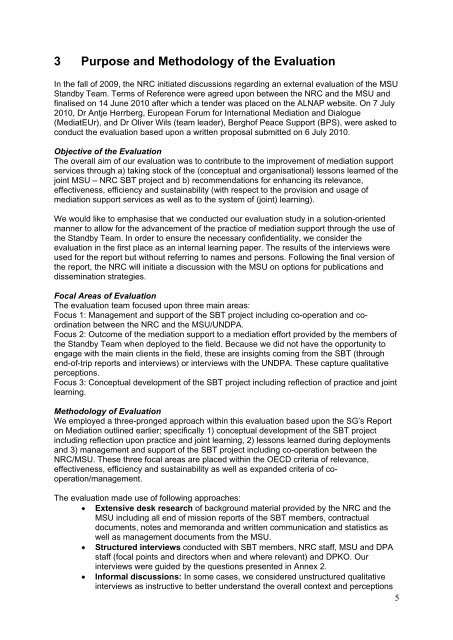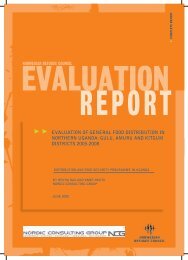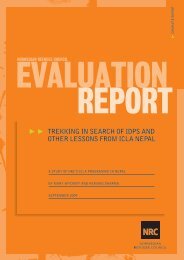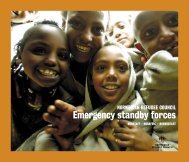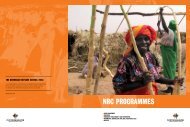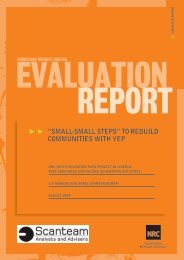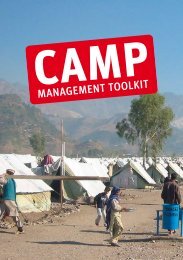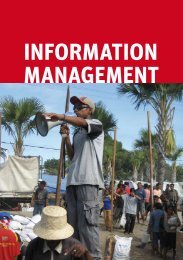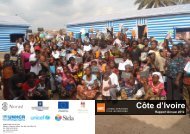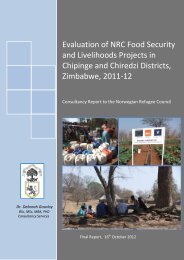Download report here - Norwegian Refugee Council
Download report here - Norwegian Refugee Council
Download report here - Norwegian Refugee Council
- No tags were found...
You also want an ePaper? Increase the reach of your titles
YUMPU automatically turns print PDFs into web optimized ePapers that Google loves.
3 Purpose and Methodology of the EvaluationIn the fall of 2009, the NRC initiated discussions regarding an external evaluation of the MSUStandby Team. Terms of Reference were agreed upon between the NRC and the MSU andfinalised on 14 June 2010 after which a tender was placed on the ALNAP website. On 7 July2010, Dr Antje Herrberg, European Forum for International Mediation and Dialogue(MediatEUr), and Dr Oliver Wils (team leader), Berghof Peace Support (BPS), were asked toconduct the evaluation based upon a written proposal submitted on 6 July 2010.Objective of the EvaluationThe overall aim of our evaluation was to contribute to the improvement of mediation supportservices through a) taking stock of the (conceptual and organisational) lessons learned of thejoint MSU NRC SBT project and b) recommendations for enhancing its relevance,effectiveness, efficiency and sustainability (with respect to the provision and usage ofmediation support services as well as to the system of (joint) learning).We would like to emphasise that we conducted our evaluation study in a solution-orientedmanner to allow for the advancement of the practice of mediation support through the use ofthe Standby Team. In order to ensure the necessary confidentiality, we consider theevaluation in the first place as an internal learning paper. The results of the interviews wereused for the <strong>report</strong> but without referring to names and persons. Following the final version ofthe <strong>report</strong>, the NRC will initiate a discussion with the MSU on options for publications anddissemination strategies.Focal Areas of EvaluationThe evaluation team focused upon three main areas:Focus 1: Management and support of the SBT project including co-operation and coordinationbetween the NRC and the MSU/UNDPA.Focus 2: Outcome of the mediation support to a mediation effort provided by the members ofthe Standby Team when deployed to the field. Because we did not have the opportunity toengage with the main clients in the field, these are insights coming from the SBT (throughend-of-trip <strong>report</strong>s and interviews) or interviews with the UNDPA. These capture qualitativeperceptions.Focus 3: Conceptual development of the SBT project including reflection of practice and jointlearning.Methodology of EvaluationWe employed a three-pronged approach within this evaluation based upon the SG s Reporton Mediation outlined earlier; specifically 1) conceptual development of the SBT projectincluding reflection upon practice and joint learning, 2) lessons learned during deploymentsand 3) management and support of the SBT project including co-operation between theNRC/MSU. These three focal areas are placed within the OECD criteria of relevance,effectiveness, efficiency and sustainability as well as expanded criteria of cooperation/management.The evaluation made use of following approaches:Extensive desk research of background material provided by the NRC and theMSU including all end of mission <strong>report</strong>s of the SBT members, contractualdocuments, notes and memoranda and written communication and statistics aswell as management documents from the MSU.Structured interviews conducted with SBT members, NRC staff, MSU and DPAstaff (focal points and directors when and w<strong>here</strong> relevant) and DPKO. Ourinterviews were guided by the questions presented in Annex 2.Informal discussions: In some cases, we considered unstructured qualitativeinterviews as instructive to better understand the overall context and perceptions5


